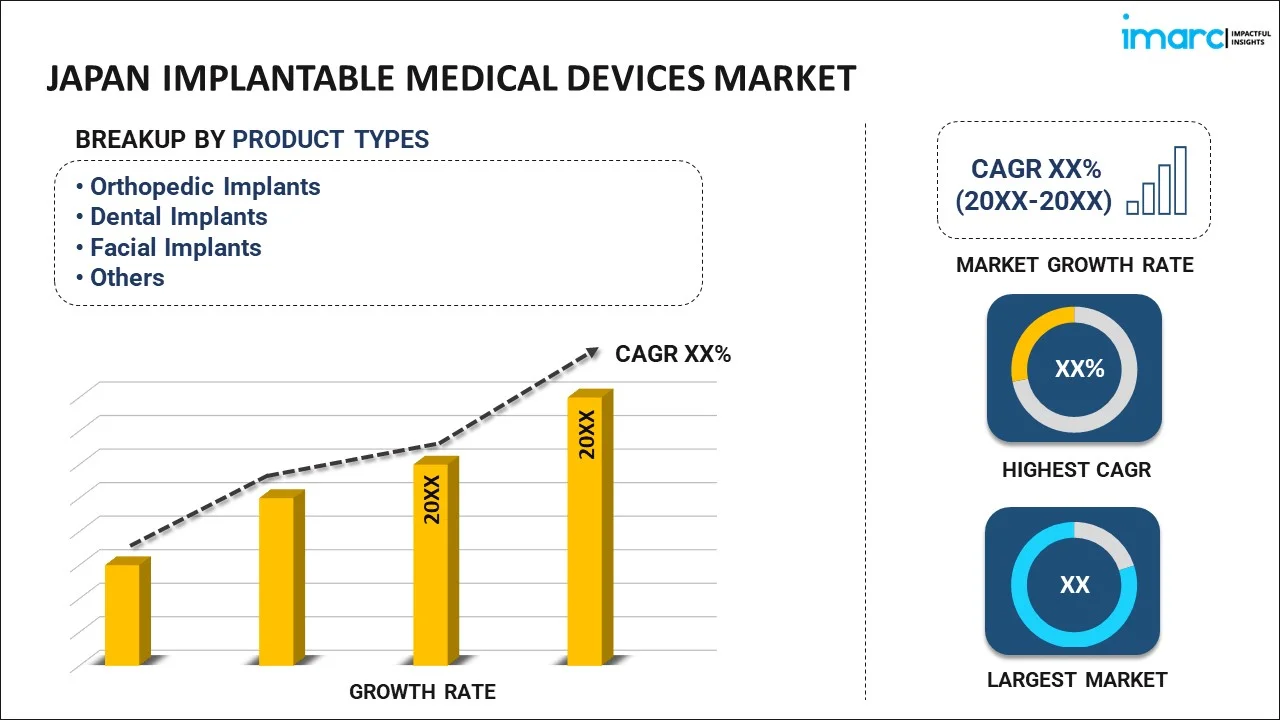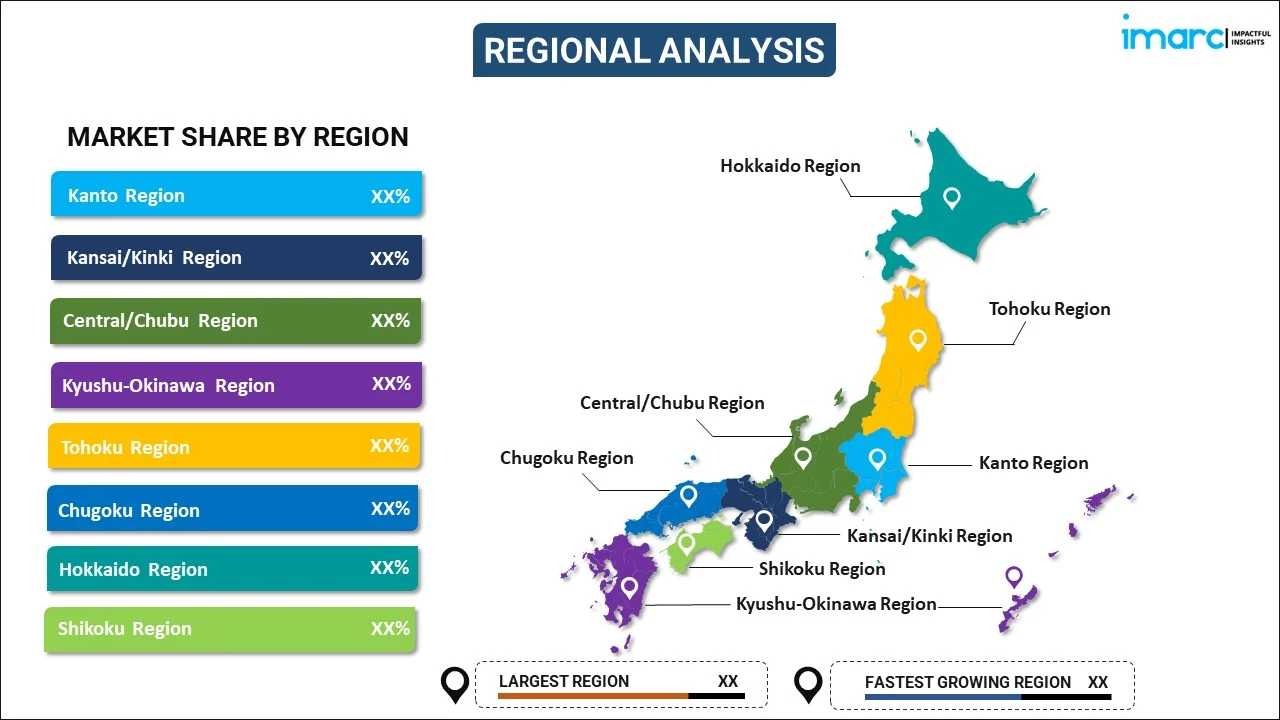
Japan Implantable Medical Devices Market Report by Product Type (Orthopedic Implants, Dental Implants, Facial Implants, Breast Implants, Cardiovascular Implants, and Others), Material (Polymers, Metals, Ceramics, Biologics), End User (Hospitals, Ambulatory Surgery Centers (ASCs), Clinics), and Region 2026-2034
Market Overview:
Japan implantable medical devices market size reached USD 8,941.6 Million in 2025. Looking forward, IMARC Group expects the market to reach USD 16,342.2 Million by 2034, exhibiting a growth rate (CAGR) of 6.93% during 2026-2034. The increasing cases of chronic diseases and age-related conditions that require implantable medical devices such as pacemakers, hip and knee implants, and defibrillators, are primarily driving the market.
|
Report Attribute
|
Key Statistics
|
|---|---|
|
Base Year
|
2025
|
|
Forecast Years
|
2026-2034
|
|
Historical Years
|
2020-2025
|
|
Market Size in 2025
|
USD 8,941.6 Million |
|
Market Forecast in 2034
|
USD 16,342.2 Million |
| Market Growth Rate 2026-2034 | 6.93% |
Implantable medical devices represent a revolutionary advancement in the field of healthcare, transforming lives with cutting-edge technology. These devices are surgically positioned inside or on the body to replace missing body parts, support organs, or enhance their functions. Some of the most well-known devices include cardiac pacemakers, which regulate heart rhythms, and cochlear implants that enable deaf individuals to hear. Moreover, devices like insulin pumps cater to diabetic patients, continuously delivering insulin to maintain glucose levels. The growth in their popularity is primarily due to their potential to significantly improve the quality of life and, in many cases, extend lifespan. As research progresses, there is anticipation for further miniaturization and increased functionalities, integrating advanced sensors and even AI capabilities. The ongoing collaboration between biomedical engineers, medical professionals, and researchers holds the promise of even more sophisticated implantable devices in the future, fostering better patient care and outcomes.
Japan Implantable Medical Devices Market Trends:
The implantable medical devices market in Japan is experiencing robust growth, primarily driven by several key factors. Firstly, the increasing prevalence of chronic diseases, such as cardiovascular disorders and diabetes, has spurred the demand for implantable devices like pacemakers and insulin pumps. Moreover, the aging population in Japan is a significant driver, as older individuals are more prone to medical conditions that necessitate these devices. Additionally, technological advancements have revolutionized the industry, making these devices more efficient, durable, and user-friendly. Furthermore, the growing awareness about the benefits of implantable medical devices among both patients and healthcare providers has led to greater adoption rates. Apart from this, the expanding healthcare infrastructure in emerging economies is creating a burgeoning market for these devices. Furthermore, regulatory initiatives aimed at streamlining the approval process and ensuring patient safety have boosted market growth. In conclusion, a convergence of demographic, technological, and regulatory factors is propelling the regional implantable medical devices market forward, with promising prospects for continued expansion.
Japan Implantable Medical Devices Market Segmentation:
IMARC Group provides an analysis of the key trends in each segment of the market, along with forecasts at the country level for 2026-2034. Our report has categorized the market based on product type, material, and end user.
Product Type Insights:

- Orthopedic Implants
- Dental Implants
- Facial Implants
- Breast Implants
- Cardiovascular Implants
- Others
The report has provided a detailed breakup and analysis of the market based on the product type. This includes orthopedic implants, dental implants, facial implants, breast implants, cardiovascular implants, and others.
Material Insights:
- Polymers
- Metals
- Ceramics
- Biologics
A detailed breakup and analysis of the market based on the material have also been provided in the report. This includes polymers, metals, ceramics, and biologics.
End User Insights:
- Hospitals
- Ambulatory Surgery Centers (ASCs)
- Clinics
The report has provided a detailed breakup and analysis of the market based on the end user. This includes hospitals, ambulatory surgery centers (ASCs), and clinics.
Regional Insights:

- Kanto Region
- Kansai/Kinki Region
- Central/ Chubu Region
- Kyushu-Okinawa Region
- Tohoku Region
- Chugoku Region
- Hokkaido Region
- Shikoku Region
The report has also provided a comprehensive analysis of all the major regional markets, which include Kanto Region, Kansai/Kinki Region, Central/ Chubu Region, Kyushu-Okinawa Region, Tohoku Region, Chugoku Region, Hokkaido Region, and Shikoku Region.
Competitive Landscape:
The market research report has also provided a comprehensive analysis of the competitive landscape in the market. Competitive analysis such as market structure, key player positioning, top winning strategies, competitive dashboard, and company evaluation quadrant has been covered in the report. Also, detailed profiles of all major companies have been provided.
Japan Implantable Medical Devices Market Report Coverage:
| Report Features | Details |
|---|---|
| Base Year of the Analysis | 2025 |
| Historical Period | 2020-2025 |
| Forecast Period | 2026-2034 |
| Units | Million USD |
| Scope of the Report | Exploration of Historical Trends and Market Outlook, Industry Catalysts and Challenges, Segment-Wise Historical and Future Market Assessment:
|
| Product Types Covered | Orthopedic Implants, Dental Implants, Facial Implants, Breast Implants, Cardiovascular Implants, Others |
| Materials Covered | Polymers, Metals, Ceramics, Biologics |
| End Users Covered | Hospitals, Ambulatory Surgery Centers (ASCs), Clinics |
| Regions Covered | Kanto Region, Kansai/Kinki Region, Central/ Chubu Region, Kyushu-Okinawa Region, Tohoku Region, Chugoku Region, Hokkaido Region, Shikoku Region |
| Customization Scope | 10% Free Customization |
| Post-Sale Analyst Support | 10-12 Weeks |
| Delivery Format | PDF and Excel through Email (We can also provide the editable version of the report in PPT/Word format on special request) |
Key Questions Answered in This Report:
- How has the Japan implantable medical devices market performed so far and how will it perform in the coming years?
- What has been the impact of COVID-19 on the Japan implantable medical devices market?
- What is the breakup of the Japan implantable medical devices market on the basis of product type?
- What is the breakup of the Japan implantable medical devices market on the basis of material?
- What is the breakup of the Japan implantable medical devices market on the basis of end user?
- What are the various stages in the value chain of the Japan implantable medical devices?
- What are the key driving factors and challenges in the Japan implantable medical devices?
- What is the structure of the Japan implantable medical devices market and who are the key players?
- What is the degree of competition in the Japan implantable medical devices market?
Key Benefits for Stakeholders:
- IMARC’s industry report offers a comprehensive quantitative analysis of various market segments, historical and current market trends, market forecasts, and dynamics of the Japan implantable medical devices market from 2020-2034.
- The research report provides the latest information on the market drivers, challenges, and opportunities in the Japan implantable medical devices market.
- Porter's five forces analysis assist stakeholders in assessing the impact of new entrants, competitive rivalry, supplier power, buyer power, and the threat of substitution. It helps stakeholders to analyze the level of competition within the Japan implantable medical devices industry and its attractiveness.
- Competitive landscape allows stakeholders to understand their competitive environment and provides an insight into the current positions of key players in the market.
Need more help?
- Speak to our experienced analysts for insights on the current market scenarios.
- Include additional segments and countries to customize the report as per your requirement.
- Gain an unparalleled competitive advantage in your domain by understanding how to utilize the report and positively impacting your operations and revenue.
- For further assistance, please connect with our analysts.
 Request Customization
Request Customization
 Speak to an Analyst
Speak to an Analyst
 Request Brochure
Request Brochure
 Inquire Before Buying
Inquire Before Buying




.webp)




.webp)












